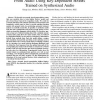Free Online Productivity Tools
i2Speak
i2Symbol
i2OCR
iTex2Img
iWeb2Print
iWeb2Shot
i2Type
iPdf2Split
iPdf2Merge
i2Bopomofo
i2Arabic
i2Style
i2Image
i2PDF
iLatex2Rtf
Sci2ools
TASLP
2008
2008
Acoustic Chord Transcription and Key Extraction From Audio Using Key-Dependent HMMs Trained on Synthesized Audio
We describe an acoustic chord transcription system that uses symbolic data to train hidden Markov models and gives best-of-class frame-level recognition results. We avoid the extremely laborious task of human annotation of chord names and boundaries--which must be done to provide machine learning models with ground truth--by performing automatic harmony analysis on symbolic music files. In parallel, we synthesize audio from the same symbolic files and extract acoustic feature vectors which are in perfect alignment with the labels. We, therefore, generate a large set of labeled training data with a minimal amount of human labor. This allows for richer models. Thus, we build 24 key-dependent HMMs, one for each key, using the key information derived from symbolic data. Each key model defines a unique state-transition characteristic and helps avoid confusions seen in the observation vector. Given acoustic input, we identify a musical key by choosing a key model with the maximum likelihood,...
| Added | 15 Dec 2010 |
| Updated | 15 Dec 2010 |
| Type | Journal |
| Year | 2008 |
| Where | TASLP |
| Authors | Kyogu Lee, Malcolm Slaney |
Comments (0)

